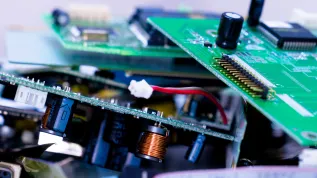
Light can transfer quantum information up to 50 times faster thanks to a time lens used by physicists from the University of Warsaw in a converter that changes the properties of photons. In the near future, this technology may contribute to building super-fast connections of the quantum Internet, the university reports.
Dr. Michał Karpiński, head of the Quantum Photonics Laboratory at the Faculty of Physics of the University of Warsaw explains that light enables high-speed data transmission around the world via fibre-optic telecommunication networks. This information-carrying capability can be extended to transmitting quantum information by encoding it in single particles of light - photons.
'To efficiently load single photons into quantum information processing devices, they must have specific properties: the right central wavelength or frequency, a suitable duration, and the right spectrum,’ says Karpiński, co-author of the paper published in Nature Photonics https://www.nature.com/articles/s41566-023-01214-z.
LENS GLASS THICKNESS CHANGES WITH TIME
Quantum computers are being built by researchers around the world using a variety of techniques, including trapped ions, quantum dots, superconducting electric circuits, and ultracold atomic clouds. These quantum information processing platforms operate on a variety of time scales: from picoseconds through nanoseconds to microseconds. In order to connect such devices together and create a quantum network, an interface is needed to change the characteristics of transmitted quantum pulses of light - individual photons.
In their paper in Nature Photonics, the scientists present a prototype converter that allows for up to a 200-fold change in the pulse duration, with an efficiency of 25 percent. According to Dr. Karpiński, this means that the resulting quantum Internet link could operate up to 50 times faster. The critical part of the new technique developed by researchers at the University of Warsaw is called a time lens.
Dr. Filip Sośnicki of the Quantum Photonics Laboratory, who was responsible for developing the experiment, says: ‘A classical spatial lens, the kind we are normally familiar with, changes the size of a beam of light, either focusing it or diverging it. For example, light can be focused by using a convex lens - one in which the thickness of the lens’ glass decreases with increasing distance from its centre. By a similar principle, a time lens can either shorten or lengthen light pulses, but here the effective optical thickness of the glass changes in time, not in space.
'To focus a wide beam of light using a spatial lens, it must be large enough. But this will make the lens highly convex, significantly increasing the amount, and therefore the weight, of the glass required to make it. To avoid this, we can use a Fresnel lens, whose specific shape reduces the thickness of such a lens to just a few millimeters or less. In our research, we developed a temporal equivalent of such a lens, which we call a Fresnel time lens.’
Fresnel lenses are used in a variety of applications, including car headlights, lighthouses, railroad signals, and even smartphone cameras.
STRONG EFFECT WITHOUT DAMAGE TO THE LENS
The researchers took advantage of an electro-optic effect. It alters the refractive index of a crystal (in this case, lithium niobate), depending on changes in an external electric field applied to it. Using fast electric signals, it is possible to achieve a time-varying optical thickness of the crystal needed to create a time lens. However, excessively high electric field can destroy the crystal.
'In the technique we have developed, we increase the refractive index in stages, similar to a spatial Fresnel lens. This way, we achieve a strong effect without destroying the lens, which, in turn, allows for more extensive modifications of quantum light pulses,’ says Dr. Karpiński.
Such 'phased' operations require the use of ultrafast microwave electronics. Dr. Sośnicki compares that high-speed Wi-Fi or 5G networks operate at frequency bands of about 3 to 5 GHz, whereas the signals generated by the scientists from the University of Warsaw are more than 7 times faster, with frequencies as high as 35 GHz.
The physicists intend to test interfacing between different types of quantum information processing platforms and increase the photon transmission distance. 'So far, we have been transferring single photons between devices in one laboratory. Next, we will try to perform such transfers between different buildings and even cities', says Dr. Karpiński.
As emphasized on the University of Warsaw website, the work carried out by Dr. Karpiński’s group is an important step towards creating quantum networks. Even small networks can be used in a single quantum computer. Vast ones will give rise to the quantum Internet, enabling quantum information transfer between quantum computers in different parts of the world.
In 2016, scientists from the Faculty of Physics of the University of Warsaw, in international cooperation, presented a prototype of the converter in Nature Photonics. That device enabled a six-fold change in the duration of a single-photon pulse, with an efficiency of more than 30 percent. The technique used at the time, a simple electro-optic modulation, had technical limitations that allowed for a maximal ten-fold change in the pulse duration.
PAP - Science in Poland, Karolina Duszczyk
kol/ bar/ kap/
tr. RL













